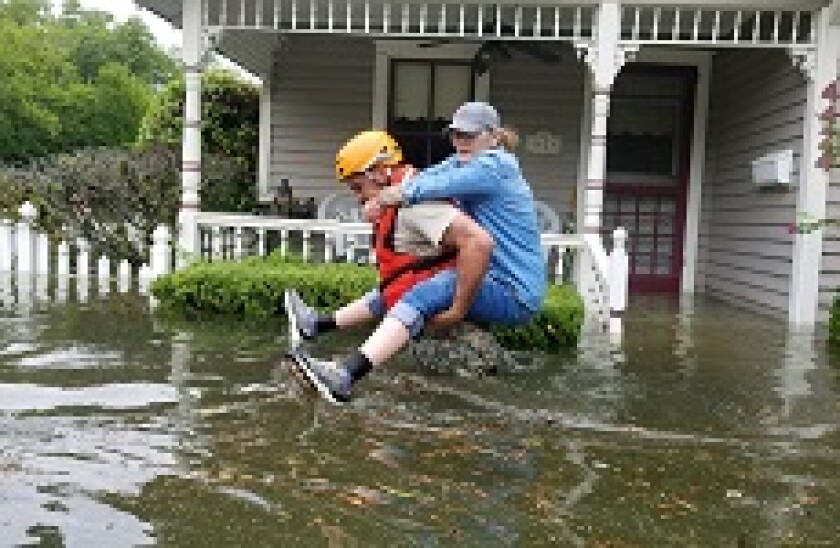Some $1.3tr of losses from natural catastrophes were not insured over the last 10 years.
In 2017 — a year in which Hurricanes Harvey, Irma and Maria ravaged the US and the Caribbean — the figure was $180bn.
One might assume this is a problem for the developing world only. After all, the P&C insurance sector looks pretty mature in developed countries in terms of growth.
But it is a worldwide issue. In 2017 the percentage of uninsured losses stood at 51% in North America and 49% in Europe — although it is worth pointing out that in Latin America and the Caribbean, Africa and Asia, the figure was much higher.
These figures come from a new report entitled 'Between State and Market: Protection gap entities and catastrophic risk' written by Paula Jarzabkowski of Cass Business School.
When losses are uninsured, governments and aid agencies may step in, or it is left to the victims to pick up the pieces.
“It is the victim, ultimately, that is paying, either financially or socially,” said Jarzabkowski at the launch of the report in London last month.
Into this breach step protection gap entities (PGEs). These bodies represent a collaboration between the public and private sectors, and work to package uninsured risk into products that can be shifted onto the financial markets.
The markets will then, the theory goes, provide capital in the wake of a disaster.
And investors outside the insurance industry can play a part in this. They can participate in catastrophe bonds or other insurance-linked securities (ILS), or provide capital through funds dedicated to these types of deals.
PGEs across the pond
One such ILS transaction is in the market.
The US’s National Flood Insurance Program (NFIP), managed by the Federal Emergency Management Agency, has launched its first catastrophe bond, according to trade site Artemis.
It is looking to issue two tranches of notes worth at least $275m to cover losses from flood events caused by named storms.
The NFIP was created in 1968 to cover the gap in the private market and reduce demand for state aid after disasters. It offers affordable coverage for flooding directly and through private insurers. Participating communities must agree to adopt and enforce flood plain management policies.
This funding model allows the burden of risk to be shared across policyholders rather than entirety being left to the state and the flood victims.
And the capital markets can help make it more resilient.
“The NFIP requires a stronger financial framework built on expanding our portfolio of actuarially-priced policies,” said Roy Wright, director of the organsiation, in April. “Transferring more of the risk burden to the private capital markets continues to be part of that strategy.”
“During the second largest loss year in the programme’s history, the reinsurance marketplace came through and supported the NFIP,” he added. “We expanded the traditional reinsurance cover earlier this year. Now we will continue that risk transfer by tapping the capital markets.”
A similar and newer PGE in the UK has similar aims.
After a rainy 2000, the UK government and insurance industry drew up a statement of principles, under which insurers would continue to insure high risk properties and for its part the state would continue to invest in flood defences.
But the agreement broke down: government spending on defences fell under the Conservative-led administration’s austerity programme. And new insurers were exempt from the agreement to cover higher risk areas, giving them a competitive advantage.
With the government scared of high risk properties being left uninsured, and insurers scared they would be forced to insure them, Flood Re emerged as a solution. It is run by industry, but all policyholders pay a levy to fund the pool.
Moral hazard
But PGEs bring their own challenges.
One risk is moral hazard: if insurance is offered at a below-the-market rate, there may be less incentive for other stakeholders to reduce risk. This is a criticism that has been levelled at the NFIP.
That programme is also struggling to stay self-sufficient.
“It likely will not generate sufficient revenues to repay the billions of dollars borrowed from the Department of the Treasury to cover claims from the 2005 and 2012 hurricanes or potential claims related to future catastrophic losses,” said the US Government Accountability Office in a report last year.
“Since the programme offers rates that do not fully reflect the risk of flooding, the NFIP’s overall rate-setting structure was not designed to be actuarially sound in the aggregate, nor was it intended to generate sufficient funds to fully cover all losses,” it added.
Flood Re excludes properties built after 2009 from its scheme, in order to avoid encouraging new developments in areas prone to flooding.
It is set to be wound down in 2039. But it has said that some high risk properties would always remain uninsurable in the private market, the Financial Times reported last week.
Nevertheless, there is room for the capital markets to help such entities fulfil a social purpose, and to engage in their attempts to correct market failings.
There are similar schemes in the developing world, where the insurance market is often barely established, thus concentrating risk on aid agencies, governments and the victims.
But the flooding agencies in the UK and the US are just two examples of entities in the developed world fulfilling a similar role.
When it comes to flooding, there is also an environmental purpose to the PGE model. The modelling expertise that the insurance sector and the ILS market bring helps sharpen what we know about the effects of climate change and so can generate awareness and understanding of the need to combat it.
Investors are ever more desperate to prove they are socially responsible. Helping PGEs is an obvious way to do so.

